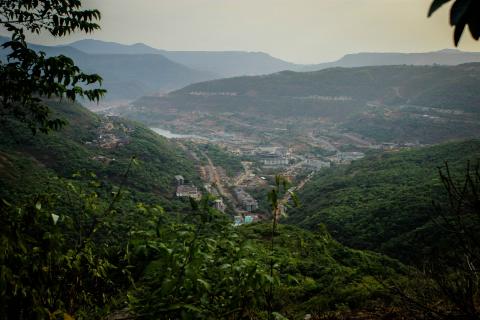
Au milieu des montagnes du Maharashtra, un rêve de promoteur émerge lentement. Un mirage pour élites : Lavasa City, la première ville indienne entièrement privée. 200 000 habitants prévus pour 2025, un mode de vie labellisé à l'occidentale, une université, un parcours de golf et des centaines de villas posées là, au beau milieu d'une jungle inscrite au patrimoine de l'Unesco. Le chantier s'étire sur des kilomètres autour des lacs artificiels créés pour l'occasion, mobilisant des milliers d'ouvriers.
 I do not know much about gods; but I think that the river is a strong brown god - sullen, untamed and intractable.
I do not know much about gods; but I think that the river is a strong brown god - sullen, untamed and intractable.
Patient to some degree, at first recognized as a frontier; useful, untrustworthy as a conveyor of commerce; then only a problem confronting the builder of bridges. The problem once solved, the brown god is almost forgotten by the dwellers in cities - ever, however, implacable, keeping his seasons and rages, destroyer, reminder of what men choose to forget. Unhonoured, unpropitiated
by worshippers of the machine. - T. S. Eliot (1888-1965) from Four Quartets
Hindu mythology tells us that river Yamuna is a goddess and the water has the power to wash away sins. However, the 22 kilometers of Yamuna that flows through Delhi is no longer fit for ablutions, divine or otherwise. « The amount of untreated sewage and industrial effluents that are directed towards the river are enough to make it very sick. Today, the state of Yamuna in Delhi is such that the thickness of the waste does not allow it to flow, except in the monsoon months » said Dr. Soni.
4% of the river flows
According to the Central Pollution Control Board (CPCB), only 4% of the Yamuna actually flows through the Capital. Ironically, this stretch is responsible for over 70% of the river’s pollution. The pollution levels of the Yamuna are such that the water is unfit even for bathing. That, however, does not stop slum dwellers from taking a bath in the river. R M Bhardwaj, Senior Scientist, CPCB, explained the limitations of the government while dealing with domestic sewage and industrial effluents disposal. « Water is a state subject. In the capital, we have the most extensive sewage treatment plants (STPs) in place. However, the amount of waste water produced by Delhi does not reach the STPs because of the lack of sewage pipelines », he said.
Pour la seconde année consécutive, l’Etat du Maharashtra, 112 millions d’habitants dont plus de la moitié de ruraux, est durement touché par la sécheresse. Alors que le plateau occidental, très urbanisé, bénéficie d'une mousson abondante, les plaines orientales, essentiellement agricoles, ne reçoivent que de maigres précipitations. Les détresses et les mesures d'intervention s'y concentrent.